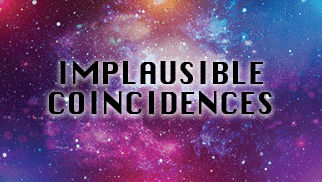Return to 2nd Quarter 2019 articles.

For the past 50 years, we have presented a large number of evidences that the creation of Earth and life on Earth cannot be a product of chance. Our arguments have been statistical, starting with the basic rule that when you have many parameters, you can estimate the total probability by multiplying the odds of all the factors involved. That approach has not changed, but the number of parameters and the odds grows with new data and information. Implausible coincidences continue to compound.
In recent years, astronomers have found thousands of planets orbiting other stars in the Milky Way. Skeptics point out that the probability of one of those planets harboring sentient beings like ourselves gets better with each new discovery.
An article by John Gribbin appeared in Scientific American (September 2018, page 96). The title of the article is “Alone in the Milky Way?” Although Gribbin suggests that some form of life exists elsewhere in the galaxy, he insists there could be no sentient beings like ourselves. The reasons for concluding that we are alone in the Milky Way galaxy are these “amazing” and “implausible” “coincidences.” In the article, Gribbin plainly states this:
Optimism about the possibilities of intelligent extraterrestrial life ignores what we know about how humans came to exist. We are here because of a long chain of implausible coincidences — many, many, many things had to go right to result in the situation in which we find ourselves. This chain is so implausible, in fact, that there is good reason to conclude that humans most likely are the only technological civilization in the galaxy.
— John Gribbin in Scientific American
That is an interesting conclusion. The article goes on to list the variables that point to that conclusion. Here is a summary of some of those variables:
SPECIAL TIMING
The elements that make up a terrestrial planet like Earth are produced from hydrogen and helium by thermonuclear fusion. Astronomers can see supernova explosions producing the heavy metals that make up a terrestrial planet and life itself, but it takes time for this process to create the necessary elements. Most of the exoplanets we see have minimal amounts of the heavy elements because they are early in their stellar evolution. Even the sun itself is 71% hydrogen and 27% helium with only 2% metals. The timing of putting the materials together to make a terrestrial planet is critical.
LOCATION IN THE GALAXY

The location of a solar system in the galaxy makes a difference. The galactic habitable zone is the area where there is a freedom from the concentration of supernovae. Systems near the center of the galaxy have high levels of radiation in the form of X-rays and cosmic rays. There is an enormous black hole in the center of our galaxy called Sagittarius A which produces massive amounts of radiation. Gamma-ray bursts occur in certain places in the galaxy. In our area of the galaxy, sterilizing radiation bursts do not happen. Recent studies of the galactic habitable zone tell us that it extends from 23,000 to 30,000 light-years from the center or only about 7% of the galactic radius. This zone contains only about 5% of the stars because stars tend to concentrate toward the core of the galaxy. Our Sun is close to the center of the galactic habitable zone providing rare long-term stability.
TYPE OF PLANET
So far astronomers have discovered about 50 “Earth-like planets.” What that means is that they have found rocky planets in the habitable zone that are about the same size as Earth. Venus would qualify as an “Earth-like planet,” but it is an excellent example of how misleading that statement is. Venus has a thick crust with no sign of plate tectonics, no magnetic field, no way to recycle materials, and no stabilizing moon. Our Moon keeps the tilt of Earth's axis at 23½ degrees providing a stable climate.
Realize that all of these factors are just to have a ball of rock in the right place at the right time with the right materials with which to make life. Now we would need to calculate the odds of getting the right chemicals together at the right time in the right place with the right catalyst to make the first living thing. Books have been written about how improbable those steps are. The writers are not religious fanatics, but scientists who are doing the research.
Based on the evidence, John Gribbin reached the conclusion that we are alone in the Milky Way:
As we put everything together, what can we say? Is life likely to exist elsewhere in the galaxy? Almost certainly yes, given the speed with which it appeared on Earth. Is another technological civilization likely to exist today? Almost certainly no, given the chain of circumstances that led to our existence. These considerations suggest we are unique not just on our planet but in the whole Milky Way. And if our planet is so special, it becomes all the more important to preserve this unique world for ourselves, our descendants and the many creatures that call Earth home.
— John Gribbin in Scientific American
We must make one additional point. If the process involved an intelligent Creator, the probability of a habitable Earth with life on it is 100%. Perhaps we are not really alone in the Milky Way because there is a God who cares about us. For those who might want to consider this option, we encourage you to watch program 6 of our video series available free on www.doesgodexist.tv. Gribbin's article concludes by describing the improbable nature of advanced human life. However, it credits evolution for the creation of that life while showing how “implausible” and “amazing” it is. We believe a supernatural intelligence was involved. We call him God.
Picture credits:
© Maximusnd. Image from BigStock.com.
© Igor Chekalin. Image from BigStock.com.
